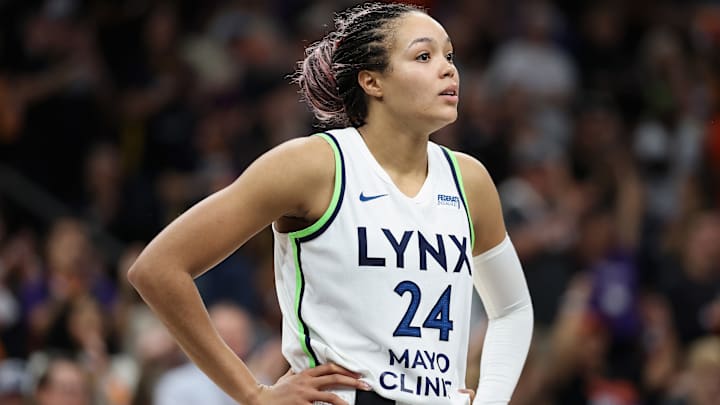The WNBA is young. And despite feeling drama-filled (it is), the league has not yet had a lockout.
The NBA, for example, has experienced a total of four lockouts. The seasons that lost games were the 1998-99 and 2011-12 seasons.
But given what’s been happening in the WNBA right now, a lockout does seem quite possible. And if a lockout does transpire, it could have a devastating impact on the WNBA’s growth, which has skyrocketed in recent years.
Alternatively, the threat of one could push the WNBA and the players' union to reach an agreement that transforms the league for the better and changes its trajectory in unfathomable ways.
Here's what we know.
Where do things stand in WNBA CBA negotiations?
The current Collective Bargaining Agreement (CBA) between the WNBA and the players’ union (WNBPA) is set to expire on Oct. 31. Why? The players opted out of the existing CBA early (it was originally to run longer) to renegotiate.
Remember that the CBA sets all the rules for the WNBA: salaries, free agency, benefits, revenue distribution, working conditions, travel, etc.
Failure to reach an agreement does not necessarily mean there is an immediate lockout. There is still a team to agree to extend the term of the current agreement to continue negotiations.
WNBPA President Nneka Ogwumike told ESPN: "Hopefully [the agreement] gets done in the time that makes sense. I don't think anyone wants to see a lockout.”
The Napheesa Collier angle
Tension has escalated after Minnesota Lynx star Napheesa Collier held an explosive press conference to criticize commissioner Cathy Englebert’s leadership and treatment of the players.
The two-time Olympic gold medalist is vice president of the WNBPA.
"I just got to the point where I was fed up," Collier said about her scathing statement: "No matter the consequences, I felt like it was something that needed to be done."
Collier spoke to former Vice President Kamala Harris this week, adding, "I never had planned to do that. I am on the union for CBA negotiations ... and for so long, I felt like I saw what was going on behind closed doors. For so long, we tried to have these conversations and move the needle. ... And I saw nothing was changing."
Collier also cancelled an upcoming meeting with Englebert. The tension between the two has raised speculation that a lockout is seriously possible.
Collier is also the founder of the Unrivaled basketball league, which begins its second season in January 2025. It is seen as the biggest threat to the WNBA.
What does the union want?
There are a handful of things the players have wanted for years. At the top of the list is a better revenue-sharing system, so that as the league continues to grow, player compensation grows, too.
Revenues are projected to top $1 billion this year. Sports economist and professor David Berri wrote in The New York Times that if WNBA players received a similar percentage of "basketball-related income" as NBA players, the top stars should be making more than $3 million a year. Instead, they earn less than 10% of that.
According to ESPN, under the current CBA, players don't get additional revenue sharing (9 percent as opposed to 49-51 percent in the NBA) until the league has generated a certain level of revenue, which it says it has yet to do after decades of multimillion-dollar losses at the franchise and league level.
Other desired changes are higher salary caps and bigger “max” salaries, more roster spots, better travel and facilities, improved benefits, and looser or removed restrictions on playing overseas or in new leagues.
Here is what the association's official statement said in October 2024: “The WNBPA advocates for a new equity-based financial structure, moving away from restrictive caps on compensation, with demands for enhanced retirement benefits, child care, and family planning options.”
Lockout scenarios
There are good and bad scenarios.
Obviously, the best-case scenario is that an agreement is reached before or just after the Oct. 31 deadline. By finalizing a potential new multi-year CBA by then, that is everything the WNBPA wants; free agency won’t be impacted.
WNBA free agency negotiations typically begin in mid-January, with player contracts becoming officially signable on Feb. 1st. Training camps usually begin around April.
It’s important to know that the Unrivaled season begins in January 2026 with eight teams and featuring 54 players, including many stars like Rookie of the Year Paige Bueckers.
A both good and a bad case scenario is that negotiations drag out and both sides agree to extend the current CBA for a set amount of time to avoid an immediate lockout. But with players still playing under the old terms for the 2026 season while bargaining continues, things could get very tense ahead of a new permanent deal.
And then there’s the worst-case scenario, in which negotiations break down after the deadline and there isn’t even a temporary extension.
That would obviously mean that the WNBA season is delayed or shortened, possibly starting mid-summer 2026. It would likely be a huge hit to the momentum the league has gained over the years.
What actually happens in a lockout?
Immediately, players lose access to: team facilities (think gyms, rehab, training rooms), as well as team medical and training staff. There are no team practices, as well as no league-organized workouts or events.
All league operations freeze: No trades, signings, or free agency. No rookie contracts or extensions can be finalized. Further, pay will stop. Because the CBA governs player pay, without one, there are no salaries or bonuses.
